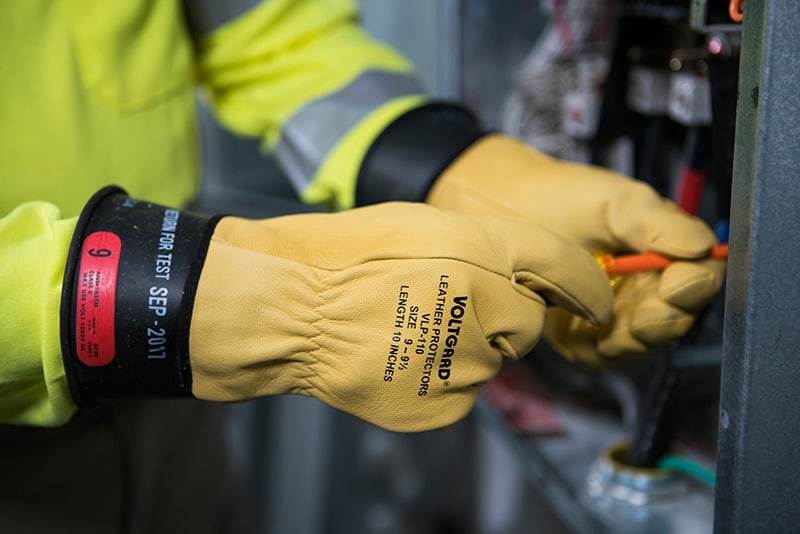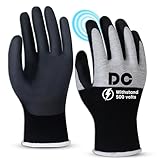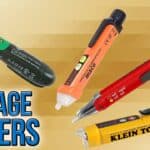In the world of electrical work, precision is key, but safety is non-negotiable. For an electrician, hands are the primary tools, and they are constantly exposed to the invisible and lethal risk of electrical shock. Choosing the right electrician gloves isn’t just a preference—it’s one of the most critical safety decisions you’ll make every day.
This guide breaks down the essential factors for selecting the correct gloves, explains the critical safety standards, and details the types of gloves you need to stay safe on the job.
Key Takeaways:
- Glove Class is Critical: Always match the glove’s “Class” rating (e.g., Class 0, Class 1) to the maximum voltage you will be working with.
- It’s a Two-Part System: You MUST use rubber insulating gloves (for shock protection) under leather protector gloves (for puncture protection).
- Inspect Before Every Use: Perform a visual check and an air-inflation test on your rubber gloves before every use. A pinhole can be fatal.
- Know Your Dates: Rubber insulating gloves have an “expiration date” and must be re-tested by a certified lab every 6 months.
Why Your Glove Choice is Critical
Electricians perform physically demanding tasks, often near live electrical currents. A minor mishap, like a pinhole in a glove, can lead to a fatal shock. Beyond shock, hands are exposed to cuts, punctures, and abrasions. A simple scrape or cut can become a secondary point of contact for an electrical current, bypassing the glove’s protection.
Understanding that electrician gloves are a complete system is the first step to ensuring your safety.

Proper selection involves matching the glove’s voltage class to the job’s hazard level.
How to Choose the Right Electrician Gloves
Selecting the right glove involves more than just finding your size. You must match the glove to the specific hazard.
1. Voltage Protection: The Glove Class System
The most important factor is the glove’s Class rating. This rating, set by ASTM D120 standards, indicates the maximum voltage the glove is designed to protect against. Using a glove with a rating lower than the voltage you are working with can be fatal.
Common Electrical Glove Classes (ASTM D120):
| Class | Label Color | Max Use Voltage (AC) | Max Use Voltage (DC) |
|---|---|---|---|
| Class 00 | Beige | 500V | 750V |
| Class 0 | Red | 1,000V | 1,500V |
| Class 1 | White | 7,500V | 11,250V |
| Class 2 | Yellow | 17,000V | 25,500V |
| Class 3 | Green | 26,500V | 39,750V |
| Class 4 | Orange | 36,000V | 54,000V |
For most residential, commercial, and light industrial work, Class 00 and Class 0 gloves are the most common.
2. The Two-Glove System: Insulators and Protectors
It is a critical error to think leather gloves and rubber gloves are two different options for shock protection. They are two halves of a single safety system.
A) Rubber Insulating Gloves
These are the primary gloves that provide the dielectric protection. They are made from rubber or synthetic materials that are carefully manufactured and tested to stop electrical current. However, this rubber is soft and easily punctured, cut, or abraded, which would instantly destroy its protective value.
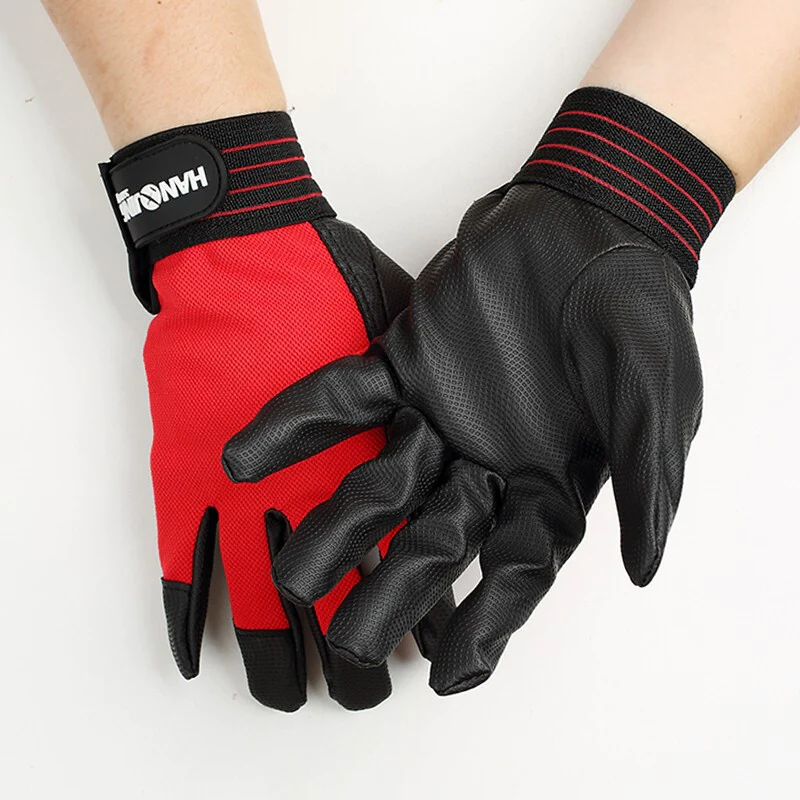
These rubber gloves provide the actual dielectric insulation from electric shock.
B) Leather Glove Protectors
These leather gloves are worn over the rubber insulating gloves. Their sole purpose is to protect the rubber insulators from mechanical damage like cuts, abrasions, and punctures. They offer zero voltage protection on their own. Never use leather protectors alone for shock protection.
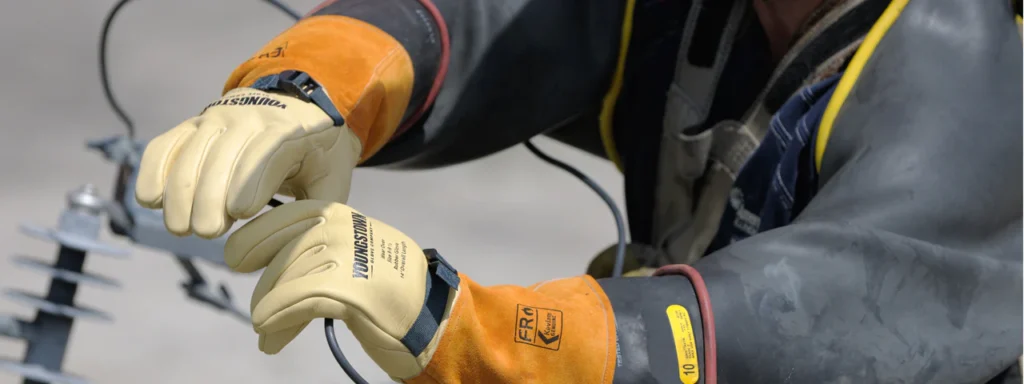
Leather protectors are worn *over* rubber insulators to protect them from punctures and cuts.
3. Fit, Comfort, and Dexterity
Your gloves must fit properly. A poor fit is both a comfort and a safety issue.
- Too Small: Gloves will be over-stretched, causing hand fatigue and making the rubber more susceptible to tearing.
- Too Large: Oversized gloves will severely reduce your dexterity, making it difficult to handle small tools, terminations, and wires. This “clumsiness” can lead to dropped tools or accidental contact.
Always try on the insulating glove *with* its leather protector over it to ensure you still have acceptable dexterity for the job.
4. Other Glove Types for Non-Energized Work
When not working on or near live circuits (and after performing a lockout/tagout), electricians use other gloves for general tasks.
Cut-Resistant Gloves
For tasks like pulling wire, terminating, working with conduit, or demo work, a simple pair of leather or coated work gloves provides crucial protection against cuts and scrapes. For added safety, choose gloves with an ANSI/ISEA 105 cut-level rating.
- A1-A3: Good for general-purpose work, low cut hazards.
- A4-A6: Ideal for utility work, wire pulling, and handling cable tray, offering significant protection.
Disposable Gloves
Disposable nitrile or vinyl gloves offer no shock or cut protection. However, they are excellent for messy jobs, like handling wire-pulling lubricant (“wire snot”), resins, or solvents, to keep your hands clean. They can sometimes be worn *under* rubber insulators for hygiene, but this may affect the fit and should be done with caution.
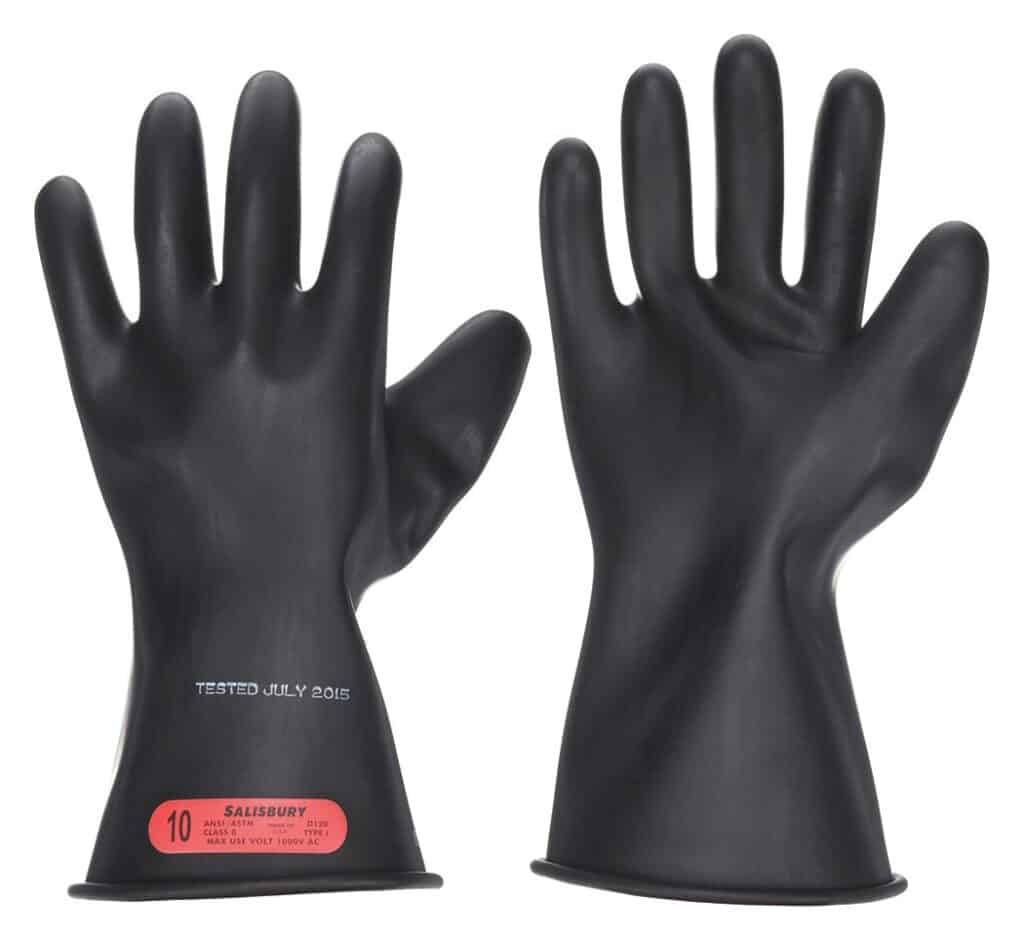
Disposable nitrile gloves are useful for messy jobs like applying wire-pulling lubricant.
Glove Inspection and Care: Your Life Depends on It
Owning the gloves isn’t enough. You must inspect and care for them meticulously. A damaged glove is worse than no glove at all, as it provides a false sense of security.
The Pre-Use Inspection Checklist
Before every single use, perform this inspection on your rubber insulating gloves:
- The Air Test (Inflation): Trap air in the glove by rolling the cuff tightly. Squeeze the glove to inflate it. Listen for leaks and hold it near your face to feel for any escaping air. Any pinhole means the glove must be destroyed.
- The Visual Test: While inflated, stretch small sections and visually inspect the entire surface (inside and out) for:
- Punctures, pinholes, or tears
- Discoloration (a potential sign of chemical damage)
- Swelling or “ballooning” in certain areas
- Hardening or cracking (ozone damage)
- Embedded material (metal shavings, splinters)
- Check the Leather Protectors: Inspect your leather protectors for holes, embedded metal, or abrasive dirt that could damage the rubber glove underneath.
When to Immediately Destroy a Glove
- If it fails the air test (even for a “tiny” pinhole).
- If it’s passed its 6-month re-test date (see below).
- If it has obvious punctures, rips, or cuts.
- If it shows signs of chemical damage, swelling, or hardening.
When in doubt, throw it out. A new pair of gloves is infinitely cheaper than a hospital visit… or worse.
Expiration, Re-Testing, and Storage
- Re-Testing: Insulating gloves must be electrically re-tested by a certified lab every 6 months (per OSHA/ASTM standards). This “expiration date” is stamped on the cuff. Never use gloves that are past their test date.
- Storage: Store your insulating gloves in a proper, durable glove bag, cuffs-down. Never fold, crimp, or stuff them in a tool bucket. Store them away from sunlight, heat, and ozone sources (like electric motors).
Best Electrician Gloves You Can Buy
While the “best” glove is the one with the correct Class rating for your job, you should always buy from reputable manufacturers who clearly state their ASTM D120 compliance. Below are some top-rated electrician glove kits (which include insulators and protectors) and accessories available.
- Insulation Performance: The palm part of the work gloves is insulated, making them ideal for use as an additional safety measure when working with electrical equipment under 1000V.
- Rubber Palm: The gloves have rubber palms that offer strong insulating and flame-retardant properties, providing safety and reliability during use.
- Anti-Slip Grip: The textured palms ensure a firm grip with anti-slip design, helping you handle tasks with confidence and prevent mistakes.
- Durable Nylon Fabric: Made from nylon fabric, the electrician's gloves are tough, resistant to wear and aging, and have a long-lasting lifespan.
- Versatile Use: These gloves are perfect for a range of home and professional tasks, such as handling instruments, appliances, mechanical equipment, automotive work, and other installation and maintenance projects.
- Insulation Performance: The palm part of the work gloves is insulated, making them ideal for use as an additional safety measure when working with electrical equipment under 400V.
- Rubber Palm: The gloves have rubber palms that offer strong insulating and flame-retardant properties, providing safety and reliability during use.
- Anti-Slip Grip: The textured palms ensure a firm grip with anti-slip design, helping you handle tasks with confidence and prevent mistakes.
- Durable Nylon Fabric: Made from nylon fabric, the electrician's gloves are tough, resistant to wear and aging, and have a long-lasting lifespan.
- Versatile Use: These gloves are perfect for a range of home and professional tasks, such as handling instruments, appliances, mechanical equipment, automotive work, and other installation and maintenance projects.
- Insulation Performance: The palm part of the work gloves is insulated, making them ideal for use as an additional safety measure when working with electrical equipment under 500V.
- Rubber Palm: The gloves have rubber palms that offer strong insulating and flame-retardant properties, providing safety and reliability during use.
- Anti-Slip Grip: The textured palms ensure a firm grip with anti-slip design, helping you handle tasks with confidence and prevent mistakes.
- Durable Nylon Fabric: Made from nylon fabric, the electrician's gloves are tough, resistant to wear and aging, and have a long-lasting lifespan.
- Versatile Use: These gloves are perfect for a range of home and professional tasks, such as handling instruments, appliances, mechanical equipment, automotive work, and other installation and maintenance projects.
- SNUG AND COMFORTABLE FIT: Nylon-Spandex material conforms to hand shape enabling detailed work while maintaining manual dexterity while working
- TEAR AND ABRASION RESISTANT: Ideal everyday work gloves with tear and abrasion resistance, exceptional flexibility, and dexterity
- SUPERIOR GRIP IN ALL CONDITIONS: Microfoam nitrile dip coating offers exceptional grip in dry, oily, and wet conditions
- ANSI A1 CUT RESISTANCE: Nylon-Spandex A1 gloves offer a light level of cut resistance making these gloves the perfect solution for a variety of jobs
- TOUCHSCREEN CAPABLE FINGERTIPS: Maintain touchscreen connectivity and protection needed on the jobsite
- 【 Insulation Performance 】 Work gloves have insulated palms and fingers and comply with ASTM D120 standard, providing effective safety protection when operating electrical equipment at 1000V and below
- 【Rubberized Palm&Fingers】 The slip resistant gloves are made of rubber and have excellent insulating properties with good flame retardant properties to provide safety and reliability during operation
- 【Rubberized Non-Slip Design】The texture on the palm of Nylon gloves increases friction through a anti-slip design, giving you a better grip on your tools and ensuring that no mistakes are made
- 【Durable Flexible Nylon 】Made of wear-resistant and breathable nylon fabric, strong and durable, flexible to wear, breathable and comfortable, with a long service life
- 【Multi-Scene Application】The electrical insulated gloves are suitable for handling home repair and professional electrician work tasks, such as automotive repair, electrical repair, installation and maintenance of mechanical equipment, etc
- 【JSBAGGT Insulated Electrician Gloves】Work gloves men have rubber palms that offer strong insulating properties,making them ideal for use as an additional safety measure when working with electrical equipment under 400V.It is your best choice when operating electrical equipment
- 【Sensitive Touch】The finger part uses advanced touch-screen sensing materials, so you can easily operate smartphones and various touch-screen devices without taking off the gloves. There is no need to interrupt the operation to take off the gloves during work, which greatly improves the convenience of work
- 【Exquisite Craftsmanship】JSBAGGT 400V insulated electrical gloves are lightweight, flexible, dexterous and comfortable to wear. Excellent breathability keeps your hands dry and cool, effectively improving work efficiency. The thin material significantly improves the sensitivity of hand operation while ensuring insulation performance
- 【Widely Applicable】Whether it is a professional electrician or daily home maintenance, this insulating glove can be perfectly adapted. It is suitable for a variety of home and professional scenarios, such as instrument operation, electrical appliance maintenance, mechanical equipment maintenance, car repair, and various installation and maintenance projects, providing all-round safety protection for your operation
- 【Package includes】Each set includes 1 pair of high-quality work gloves, and also comes with a voltage test screwdriver (For Use With Your Work Gloves)
Gloves Are Just One Part of Your PPE System
Protective gloves are fundamental, but they are partof a larger Personal Protective Equipment (PPE) system. True electrical safety is about layering defenses:

- Lockout/Tagout (LOTO): The safest way to work is on a de-energized circuit. Always follow proper LOTO procedures.
- Insulated Tools: Use tools rated for 1000V (VDE-certified) when working on or near live components.
- EH-Rated Boots: Electrical Hazard (EH) boots provide a secondary source of insulation from the ground.
- Arc Flash (AF) Gear: For high-energy work, this includes safety glasses, hard hats with face shields, and fire-resistant (FR) clothing.
- Voltage Testers: Never trust a circuit is dead. Always verify with a reliable voltage tester.
Frequently Asked Questions (FAQ)
Q: How often should I inspect my electrician gloves?
A: You must perform a visual check and an air-test inflation check before every single use. No exceptions.
Q: Can disposable gloves be used for shock protection?
A: Absolutely not. Disposable nitrile or vinyl gloves offer zero voltage protection and should never be used near live components.
Q: What safety standards should insulating gloves meet?
A: In the US, look for gloves meeting ASTM D120. This compliance should be clearly printed on the glove, along with its Class (00, 0, 1, etc.).
Q: Are leather gloves all I need for low-voltage work?
A: No. Leather gloves provide mechanical protection (from cuts), not electrical protection. You MUST wear them over the proper class-rated rubber insulating gloves to protect the rubber from damage.
Q: What is a Class 0 glove used for?
A: A Class 0 (Red Label) glove is rated for a maximum use of 1,000V AC. It is very common for commercial, industrial, and residential electricians.
Q: What does the “test date” on my gloves mean?
A: This is the “re-test” date. OSHA requires that rubber insulating gloves be electrically tested by a certified lab every 6 months to ensure they are still safe. Never use an expired glove.
Q: How do I store my rubber insulating gloves?
A: Store them in a dedicated, durable glove bag, cuffs-down. Do not fold, bend, or store them with sharp tools. Keep them out of direct sunlight and away from high heat.
Conclusion
Selecting the best electrician gloves is the most critical safety decision you will make on the job. Remember that it’s a two-part system: rubber insulating gloves (chosen by voltage Class) for shock protection and leather protectors for mechanical defense.
Always inspect your gloves before each use, and never work on an energized circuit if it can be avoided. Investing in high-quality, properly-rated gloves—and maintaining them—is a direct investment in your own life.

